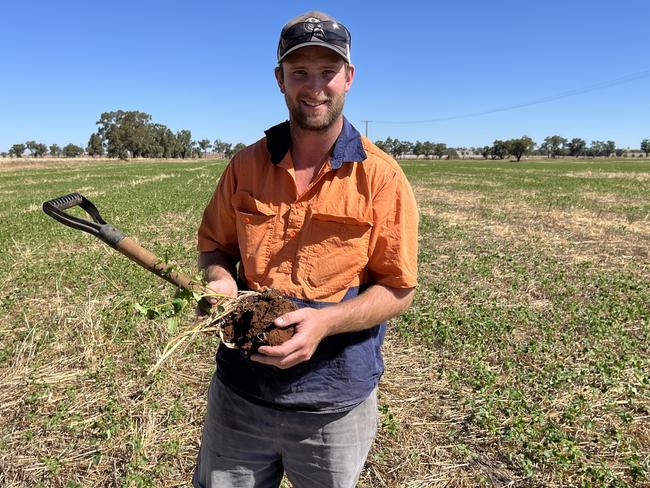Graziers use soil pits to find new ways to maximise productivity
Grazier Callum Lawson hopes opening up his soil means he will be able to find new ways to maximise his productivity on-farm.
Grazier Callum Lawson hopes opening up his soil means he will be able to find new ways to maximise his productivity on-farm.
The Avenel farmer will be one of two farmers to open up his soil for VicNoTill’s soil pit event next week. He chose to dig at one of his four properties, a paddock-to-plate sharefarm.
The 30ha soil pit paddock at Tallarook is a summer crop with sorghum, millet, sunflower, turnips, radish, rape, clover and soybeans.
“We wanted to look at something that was actually growing rather than our dry paddocks – in our dryland there’s not a lot of action going on,” he said.
“We want to see how far the roots are getting down, and being on irrigation it’ll be interesting to see because it’s been flood irrigated for 30 years.
“I think we’re going to see, because it’s been laser levelled, we’ll see an old topsoil layer, and potentially an old hardpan, and some platey hardpans from the water flood irrigation.”
Mr Lawson said he was on predominantly loamy soil, with some sandy country.
“Soil can always be improved in some way whether it be functionality, in the biology or chemistry,” he said.
The group has hosted eight soil pits across four catchment regions since 2023, from Kaniva, to Norong and southern New South Wales.

VicNoTill member Dan Fox, from Marrar, NSW, hosted one of the first eight soil pits for the group.
He said the main theme across all eight pits was the soils needed more calcium. The pits were dug between 1m-2.5m depth.
“Calcium is one of the biggest drivers of soil structure, soil porosity, water and air infiltration, and root exploration,” he said.
His topsoil was acidic, with the strongest acidity in the 10-25cm layer with aluminium levels up to 32mg/kg. The experts, Michael Eyers and Edward Scott, said the elevated pH would significantly affect root development and nutrient uptake from the layer.
“We were really surprised at what our soil pit taught us. We thought we had good-draining loam soils, but how they behaved in the wet and dry cycles where we were, we saw it’s quite good infiltration in the top 5-10cm then we have a very dispersive layer below that,” he said.
“Once you know what your soil is like, you can understand why crops and pastures are doing certain things at certain times of the year.”




